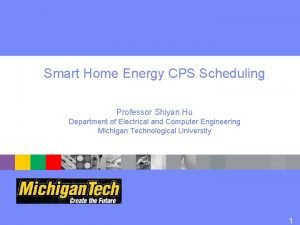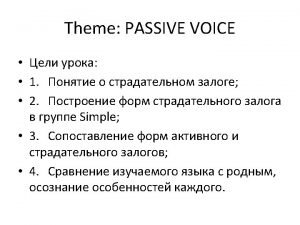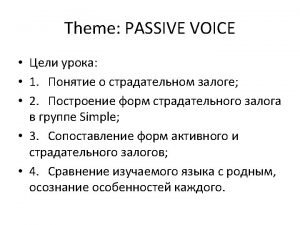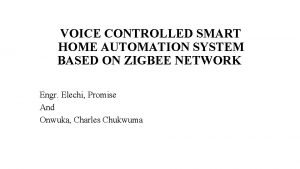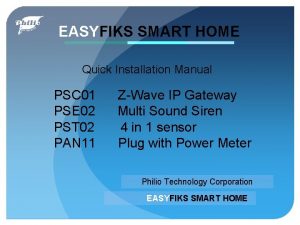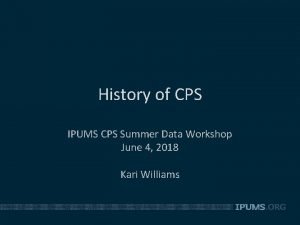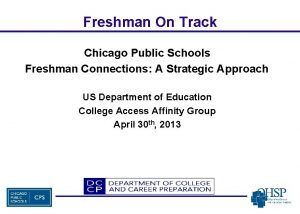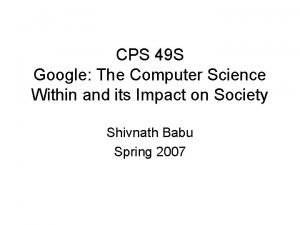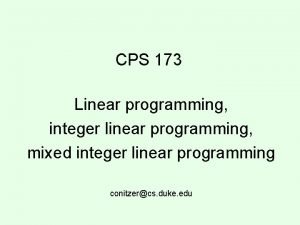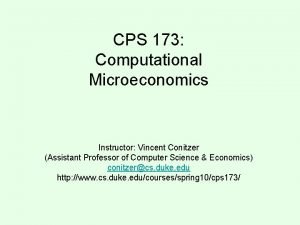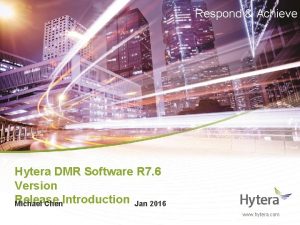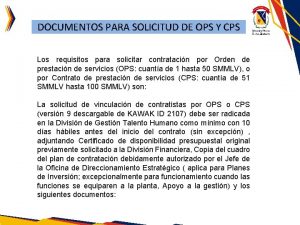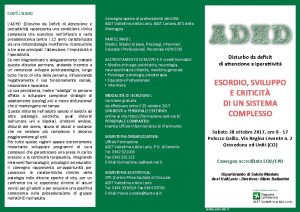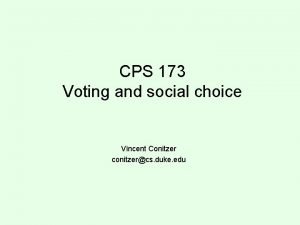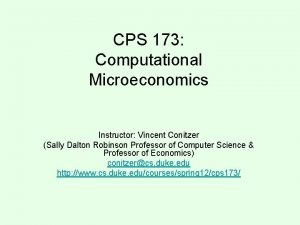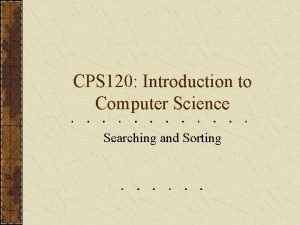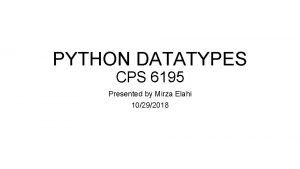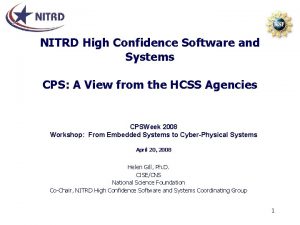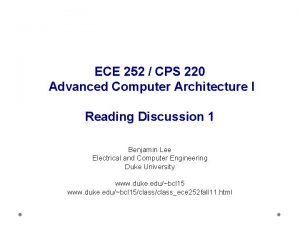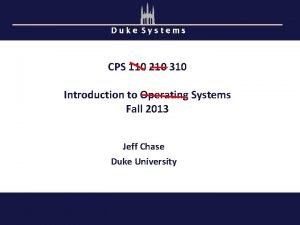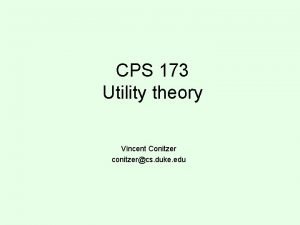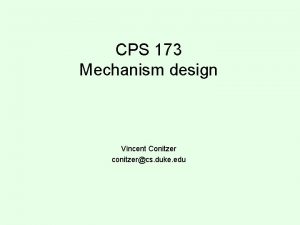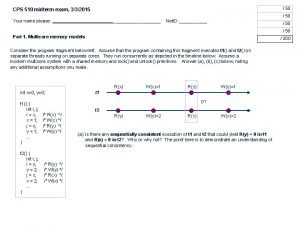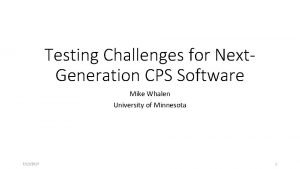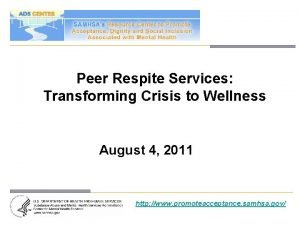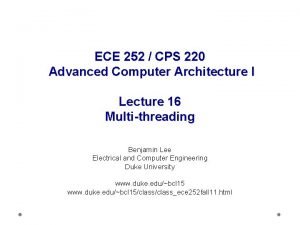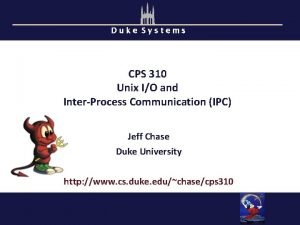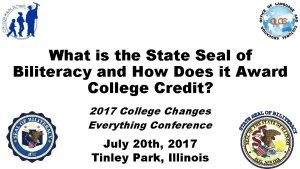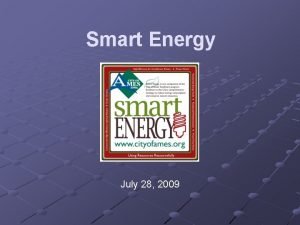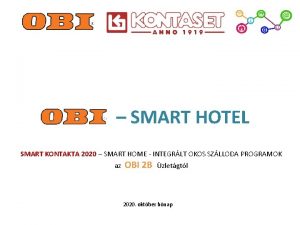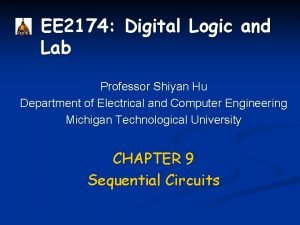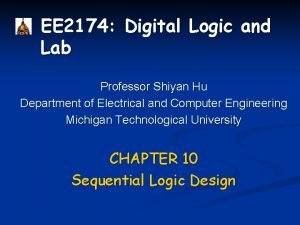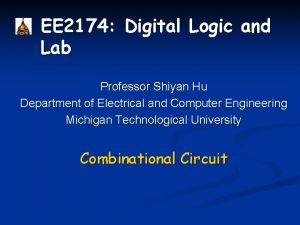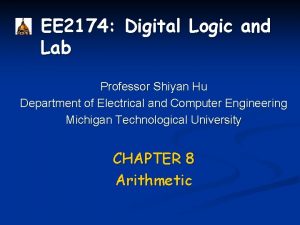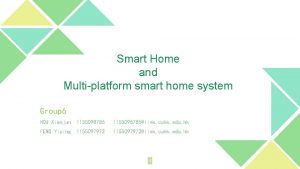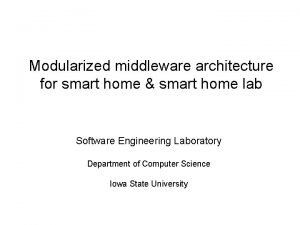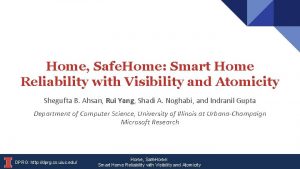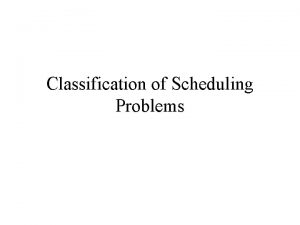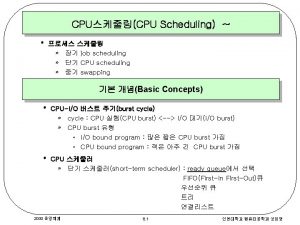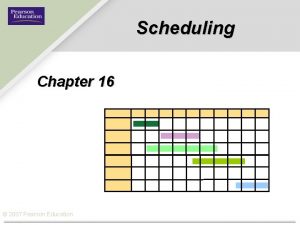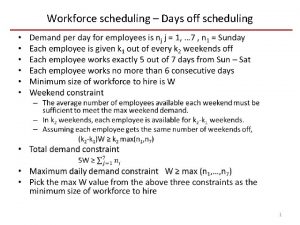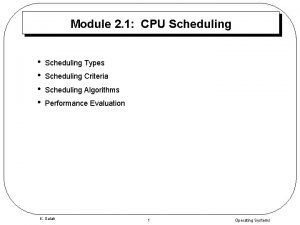Smart Home Energy CPS Scheduling Professor Shiyan Hu















































































- Slides: 79

Smart Home Energy CPS Scheduling Professor Shiyan Hu Department of Electrical and Computer Engineering Michigan Technological University 1

Smart Home: Academic Perspective 5% energy efficiency improvement in residential home energy systems leads to carbon emission reduction equivalent to removing 53 million cars in U. S. 2

Smart Home http: //www. yousharez. com/2010/11/20/house-of-dreams-a-smart-house-concept/ To Minimize Expense, Balance Energy Usage and Maximize Renewable Energy Usage 3

The Single User Smart Home Why we schedule? Power flow Internet Control flow 4

Varying Energy Consumption Typical summer energy load profile in State of Ontario, Canada. One can see the peak load around 7: 00 pm which usually involves a lot of human activities. Peak Average PAR Source: Ontario Energy Board 5

Dynamic Electricity Pricing Set high prices at peak energy hours to discourage energy usage there for energy load balancing Hourly Price from Ameren Illinois 6

Renewable Energy 7

Energy Scheduling for a Single Smart Home Given the electricity pricing, to decide when to launch a home appliance The smart home scheduler at what power level computes scheduling solutions for how long future, so it needs the future pricing. utilize renewable energy How? subject to scheduling constraints Targets Reduce user bill Reduce PAR (peak to average ratio) of grid energy usage Maximize renewable energy usage 8

Two Pricing Models: Guideline and Realtime Pricing Guideline price: utility publishes it one day ahead to guide customers to schedule their appliances, through providing the predicted pricing in the next 24 hours. Real time price: utility uses it to bill customers, e. g. , it obtains the total energy consumption in the past hour, computes the total bill as a quadratic function of the total energy, and then distributes the bill to each customer proportionally. 9

Electric Vehicles (EV) Powered by one or more Electric Motors 10

Multiple Mode Charging of EV § 2014 Honda Accord PHEV 120 -volt: less than 3 hours 240 -volt: one hour § 2013 Toyota Prius PHEV 120 -volt: less than 3 hours 240 -volt: 1. 5 hours § 2014 Chevrolet Volt PHEV 120 -volt: 10 – 16 hours 240 -volt: 4 hours Using mobile connector 29 miles of range per hour charge The fastest way to charge at home 58 miles of range per hour charge 11

Start Dish washer End 13: 00 18: 00 Landry machine 09: 00 18: 00 EV 18: 00 08: 00 AC 17: 00 N/A …… 12

Multiple Power Level (VFD) Impact Powerr Power 5 cents/kwh 3 cents / kwh 10 kwh 5 kwh 1 2 (a) Time 1 2 (b) 3 Time cost = 10 kwh * 5 cents/kwh = 50 cents cost = 5 kwh * 5 cents/kwh + 5 kwh * 3 cents/kwh = 40 cents 13

Uncertainty of Appliance Execution Time and Energy Consumption § In advanced laundry machine, time to do the laundry depends on the load. How to model it? 14

Problem Formulation § Given n home appliances, to schedule them for monetary expense minimization considering multiple power level considering variations – Solutions for continuous VFD/power level – Solutions for discrete VFD/power level Solutions for continuous VFD Solutions for discrete VFD 1 2 3 4 15

The Procedure of the Our Proposed Scheme Offline Schedule A deterministic scheduling with continuous power level A deterministic scheduling with discrete power level Stochastic Programming for Appliance Variations Online Schedule for Renewable Energy Variations 16

The Outline A deterministic scheduling with continuous power level A deterministic scheduling with discrete power level • Optimal Greedy based Deterministic Scheduling • Optimal DP based Deterministic Scheduling Stochastic Programming for Appliance Variations Online Schedule for Renewable Energy Variations 17

Linear Programming for Deterministic Scheduling with Continuous Power Level minimize: subject to: 18

Max Load Constraint To avoid tripping out, in every time window we have load constraint 19

Appliance Load Constraint Sum up in each time window appliance power consumption is equal to its input total power 20

Appliance Speed Limit and Execution Period Constraint The power is upper bounded Appliance cannot be executed before its starting time or after its deadline 21

Power Resource Power resource can be various 22

Solar Energy Distribution Constraint Solar Energy can be directly used by home appliances or stored in the battery 23

Battery Energy Storage Constraint and Charging Cost Solar Energy Storage Battery Charging Cost 24

The Proposed Scheme Outline A deterministic scheduling with continuous power level A deterministic scheduling with discrete power level • Optimal Greedy based Deterministic Scheduling • Optimal DP based Deterministic Scheduling Stochastic Programming for Appliance Variations Online Schedule for Renewable Energy Variations 25

Greedy based Deterministic Scheduling for Task i Power 0 t 1 t 2 t 3 t 4 Time Price Time Cannot handle noninterruptible home appliances 26

The Proposed Scheme Outline A deterministic scheduling with continuous power level A deterministic scheduling with discrete power level • Optimal Greedy based Deterministic Scheduling • Optimal DP based Deterministic Scheduling Stochastic Programming for Appliance Variations Online Schedule for Renewable Energy Variations 27

Dynamic Programming § Given a home appliance, one processes time interval one by one for all possibilities until the last time interval and choose the best solution 0 0 0 Choose the solution with total energy equal to E and minimal monetary cost 28

Characterizing § For a solution in time interval i, energy consumption e and cost c uniquely characterize its state Time interval i+1 (ei, ci) (ei+1, ci+1) 29

Pruning § For one time interval, (e 1, c 1) will dominate solution (e 2, c 2), if e 1>= e 2 and c 1<= c 2 Time interval i (15, 20) (15, 25) (11, 22) 30

Dynamic Programming based Appliance Optimization Power level: {1, 2, 3} Price 0 Dynamic Programming returns optimal solution (3, 6) (3, 3) (2, 4) (2, 2) (1, 1) (0, 0) t 1 (0, 0) (6, 9) (5, 7) (4, 5) (3, 3) (5, 8) (4, 6) (3, 4) (2, 2) (4, 7) (3, 5) (2, 3) (1, 1) t 2 Time 31

DP based Deterministic Scheduling For Multiple Home Appliances Determine Scheduling Appliances Order An appliance Schedule Current Home Appliance by DP Not all the appliance(s) processed Update Upper Bound of Each Time Interval All appliances are processed Schedule 32

The Proposed Scheme Outline A deterministic scheduling with continuous power level A deterministic scheduling with discrete power level • Optimal Greedy based Deterministic Scheduling • Optimal DP based Deterministic Scheduling Stochastic Programming for Appliance Variations Online Schedule for Renewable Energy Variations 33

Variation impacts the Scheme Worst case design It can be improved Cost can be reduced Best Price Window t 1 t 2 t 3 t 4 34

Best Case Design t 1 t 2 t 3 t 4 35

Variation Aware Design An adaptation variable β is introduced to utilize the load variation. t 1 t 2 t 3 t 4 36

Uncertainty Aware Algorithm Trip rate = trip out event / total event 37

The Design Flow Uncertainty Aware Algorithm 38

Algorithmic Flow Input: Task set with tasks which can be scheduled β from 0 to 0. 25 Core 1 β from 0. 25 to 0. 5 Core 2 up date task load based on β Derive current trip rate using Monte Carlo simulation No Current trip rate ≤ Target Yes β from 0. 75 to 1 Core 3 Core 4 up date task load based on β β Generate appliances schedule by solving the LP Update β β from 0. 5 to 0. 75 Generate up date task load based on β Generate appliances schedule by solving the LP Generate appliances schedule by solving the LP Update β β No solving the LP Update β Derive current trip rate using Monte Carlo simulation Current trip rate ≤ Target No Yes Current trip rate ≤ Target Yes Derive current trip rate using Monte Carlo simulation No Current trip rate ≤ Target Yes Output: Schedule 39

Algorithm Improvement § Monte Carlo Simulation takes 5000 samples § Latin Hypercube Sampling takes 200 samples Latin Hypercube Sampling is a statistical method for generating a distribution of plausible collections of parameter values from a multidimensional distribution Current S 40

The Proposed Scheme Outline A deterministic scheduling with continuous power level A deterministic scheduling with discrete power level • Optimal Greedy based Deterministic Scheduling • Optimal DP based Deterministic Scheduling Stochastic Programming for Appliance Variations Online Schedule for Renewable Energy Variations 41

Online Tuning § Actual renewable energy < Expected – Utilize energy from the power grid § Actual renewable demand > Expected – Save the renewable energy as much as possible § Actual renewable demand = Expected – Follow the offline schedule 42

Experimental Setup § The proposed scheme was implemented in C++ and tested on a Pentium Dual Core machine with 2. 3 GHz T 4500 CPU and 3 GB main memory. § 500 different task sets are used in the simulation. The number of appliances in each set ranges from 5 to 30, which is the typical number of household appliances [1]. § Two sets of the KD 200 -54 P series PV modules from Inc [2] are taken to construct a solar station for a residential unit which are cost $502. § The battery cost is set to $75 [3] with 845 k. W throughput is taken as energy storage. § The lifetime of the PV system is assumed to be 20 years [4]. § Electricity pricing data released by Ameren Illinois Power Corporation [5] [1] M. Pedrasa, T. Spooner, and I. Mac. Gill, “Coordinated scheduling of residential distributed energy resources to optimize smart home energy services, ” IEEE Transactions on Smart Grid, vol. 1, no. 2, pp. 134– 144, 2010. [2] Data Sheet of KD 200 -54 P series PV modules, available at http: //www. kyocerasolar. com/assets/001/5124. pdf. [3] T. Givler and P. Lilienthal, “Using HOMER software, NRELs micropower optimization module, to explore the role of gen-sets in small solar power systems case study: Sri lanka, ” Technical Report NREL/TP-710 -36774, 2005. [4] Lifespan and Reliability of Solar Panel, available at http: //www. solarpanelinfo. com/solarpanels/solar-panel-cost. php. [5] Real-Time Price, available at https: //www 2. ameren. com. 43

Experimental Setup on Weekday Using DP 44

Energy Consumption Distribution on Weekday Fig 1. Energy consumption distribution comparison of Test Case I. (a) Traditional scheduling (b) Dynamic Programming based scheduling. 45

Monetary Cost Distribution on Weekday Fig 2. Monetary cost comparison of Test Case I. (a) Traditional scheduling (b) Dynamic Programming based scheduling. 46

Experimental Setup on Weekend Using DP 47

Energy Consumption Distribution on Weekend Fig 3. Energy consumption distribution comparison of Test Case II. (a) Traditional scheduling (b) Dynamic Programming based scheduling. 48

Monetary Cost Distribution on Weekend Fig 4. Monetary cost comparison of Test Case II. (a) Traditional scheduling (b) Dynamic Programming based scheduling. 49

Experimental Results Using LP Cost Energy Cost (cents) household appliances time Runtime (s) household appliances 50

Traditional vs. LP vs. Discrete Greedy Cost Household appliances 51

Only DP Can Handle Non Interruptible Task set Cost Household appliances 52

Comparison of Worst Case, Best Case Design and Stochastic Design Cost Energy Cost (cents) Rate Trip Rate (%) ds n o sec 10 Household appliances 53

Cost (cents) Online vs. Offline Household appliances 54

Example of a Task Set 55

The Implementation Using FPGA 56

Schematic of FPGA Implementation 57

Summary § This project proposes a stochastic energy consumption scheduling algorithm based on the time-varying pricing information released by utility companies ahead of time. § Continuous power level and discrete power level are handled. § Simulation results show that the proposed energy consumption scheduling scheme achieves up to 53% monetary expenses reduction when compared to a nature greedy algorithm. § The results also demonstrate that when compared to a worst case design, the proposed design that considers the stochastic energy consumption patterns achieves up to 24% monetary expenses reduction without violating the target trip rate. § The proposed scheduling algorithm can always generate a monetary expense efficient operation schedule within 10 seconds. 58

Multiple Users in a Community 59

Multiple Users § Pricing at 10: 00 am is cheap, so how about scheduling everything at that time? Energy Accumlation 10: 00 am 60

Game Theory Based Scheduling 61

Game Theory Based Scheduling § For every player in a game, there is a set of strategies and a payoff function which is the profit of the player. § Each player chooses from the set of strategies in order to maximize its payoff. § When no player can increase its payoff without decreasing other users’ payoff, Nash Equilibrium is reached. 62

Game Formulation in Community Level Players: All users in the community Strategy: Choose power levels and launch time to maximize payoff while satisfying constraints 63

Community Size q. Small community: Less than 100 users q. Medium community: 100 ~5, 000 users q. Large community: More than 5, 000 users 64

Small Community: Fully Distributed Architecture In the fully distributed architecture, each customer uses own smart home scheduler to communicate with other users for information exchange and computes smart home scheduling solution. 65

Algorithmic Illustration For Small Community Iteration 1 User 2 Embedded Processor … Usern Embedded Processor Communication/Synchronization Iteration 2 User 1 User 2 Embedded Processor … Usern Embedded Processor Communication/Synchronization …… Equilibrium/Schedule 66

Algorithmic Flow For Small Community Each user schedules their own appliances separately to maximize payoff using dynamic programming All users share information with each other Each user reschedules their own appliances separately by dynamic programming No Equilibrium Yes Schedule Appliances Determine scheduling appliances order Schedule current appliance by dynamic programming All appliances scheduled No Yes Schedule 67

Single User Smart Home Scheduling Baseline Energy Usage Scheduling Range Energy Usage 68

An Example for Two Customers Customer 1 Customer 2 Total Energy Load Customer 1 Customer 2 69

Problem With The Fully Distributed Architecture Communication/synchronization problem • Assume that there are 100 iterations needed for the game theory based algorithm. • Communication/synchronization needs to be performed at the end of every iteration. • It is not realistic for big community to deploy the fully distributed architecture due to the complexity of synchronization among a large number of users. Each user performs the game theory based algorithm at their own side and communicates with all other users after every single iteration. 70

Medium Community: Fully Centralized Architecture • Users only communicate with computer cluster twice, at the beginning and end. • Communication/synchronization is not needed any more among users. • Communication/synchronization within computers or CPU cores is much easier and faster. Each user sends the scheduling tasks to a computer cluster which compute the scheduling solutions of all users. 71

Algorithmic Illustration For Medium Community User 1 User 2 Interface Parallel Computing … Usern Interface Each core schedules assigned tasks of users in parallel Run iteratively until convergence All cores share information with each other to synchronize Each core reschedules the assigned tasks given the information of other users Equilibrium Schedule Interface User 1 User 2 … Interface Usern 72

Algorithmic Flow For Medium Community User 1 Schedule tasks of users to computers Sort all computers increasingly by ratio of �� /�� User 2 Solve the continuous fashion problem combinatorially Flag all computers to be available User 3 No Runtime of computer is reaching TC Each computer runs tasks of users in parallel Run iteratively Flag the computer to be unavailable Discretize the continuous solution User 2 Yes All computers share information with each other to synchronize No # iterati ons = kϒ Equilibrium Yes Schedule User 3 Computers send back the results to users Each computer reruns the tasks of users given the information of other users Yes Usern User 1 … … Users send tasks to computer s Assign task fractionally to the available computer with lowest ratio of �� /�� Game theory based algorithm No Usern

Problem With The Fully Centralized Architecture Cannot handle large community • Communication delay • Limited computation power and high maintenance cost • Security concerns 74

Large Community: Hierarchical Architecture There are 10 million users in a big community. It can be partitioned into 2 k smaller groups, in which the number of users is 5 k. • The communication overhead within each group is acceptable. • There is no flooding packets problem. 75

Algorithmic Flow For Intra-Community Optimization User 1 User 2 Interface Parallel Computing … Userx 1 Interface Each core schedules assigned tasks of users in parallel Run iteratively until convergence All cores share information with each other to synchronize Each core reschedules the assigned tasks given the information of other users Equilibrium Schedule Continue to Inter-community optimization 76

Algorithmic Flow For Inter-Community Optimization Energy consumption summation of Intracommunity optimization Pick k time intervals with the largest total energy consumption Reduce the k energy consumption by δ Pick k time intervals with the smallest total energy consumption Increase the k energy consumption by δ Continue to Intra-community optimization/Schedule 77

Algorithmic Illustration For Large Community User 1 User 2 Interface Parallel Computing … Energy consumption Userx 1 summation of Intra. Interface community optimization Each core schedules Pick k time intervals with the largest assigned tasks of users in total energy consumption parallel Run iteratively until convergence All cores share information Reduce the k energy consumption with each other to synchronize by δ Each core reschedules the assigned tasks given the Pick k time intervals with the information of other users smallest total energy consumption Equilibrium Increase the k energy consumption Schedule by δ Continue to Intra-community optimization/Schedule Continue to Inter-community optimization 78

Summary § Single user smart home scheduling and variation aware optimization in smart home scheduling § Multiple user smart home scheduling 79
 Shiyan 3
Shiyan 3 Promotion from assistant to associate professor
Promotion from assistant to associate professor Sjn scheduling
Sjn scheduling Street smart vs book smart
Street smart vs book smart One smart man he felt smart
One smart man he felt smart It's not how smart you are
It's not how smart you are Future smart ways to pay answers
Future smart ways to pay answers It's not how smart you are
It's not how smart you are What is the next letter? a z b y c x d
What is the next letter? a z b y c x d Street smart vs book smart quotes
Street smart vs book smart quotes One smart man he felt smart
One smart man he felt smart Energy energy transfer and general energy analysis
Energy energy transfer and general energy analysis Energy energy transfer and general energy analysis
Energy energy transfer and general energy analysis Conclusion of home automation system
Conclusion of home automation system Conclusion of smart grid
Conclusion of smart grid Smart home device
Smart home device Psc 01
Psc 01 Vietablet
Vietablet Apa arti homecare
Apa arti homecare Perbedaan home care dan home visit
Perbedaan home care dan home visit Mobile home exchange
Mobile home exchange Unit 1 home sweet home
Unit 1 home sweet home Come home come home jesus is calling
Come home come home jesus is calling New mobile home sales oak springs mobile home community
New mobile home sales oak springs mobile home community America my home sweet home
America my home sweet home John heartfield
John heartfield She said that, home economics stands for the ideal home.
She said that, home economics stands for the ideal home. Home sweet home survive prayer
Home sweet home survive prayer Cps algebra exit exam
Cps algebra exit exam Cps in project management
Cps in project management Ipums cps
Ipums cps Cps freshman connection
Cps freshman connection Cps special investigator
Cps special investigator Cps molve
Cps molve Continuation-passing style
Continuation-passing style Cps 506
Cps 506 Cps 506
Cps 506 Sgoogle slides
Sgoogle slides Cps 173
Cps 173 Cps 1s
Cps 1s Cps 173
Cps 173 L-3 combat propulsion systems
L-3 combat propulsion systems E tatou cps
E tatou cps Cps template
Cps template Cps-naid
Cps-naid Cps
Cps Nielsen cps
Nielsen cps Hytera rdac software download
Hytera rdac software download Centor cps
Centor cps Ops o cps
Ops o cps Cps north west
Cps north west Cps
Cps Cps
Cps Cps boccaleone
Cps boccaleone Tasfa 21-22
Tasfa 21-22 Cps epilepsy
Cps epilepsy Lorain county child protective services
Lorain county child protective services Go.cps.edu activate account
Go.cps.edu activate account Cps 173
Cps 173 Cps 173
Cps 173 Cps 120
Cps 120 Cps test
Cps test Cps t
Cps t Cps 220
Cps 220 Cps 110
Cps 110 Cps 173
Cps 173 Cps 173
Cps 173 Cps 173
Cps 173 Cps 173
Cps 173 Cps 510
Cps 510 Cps 2017 software
Cps 2017 software Georgia mental health consumer network cps training
Georgia mental health consumer network cps training Cps
Cps Cps
Cps Cps 220
Cps 220 Cps 310
Cps 310 Olce cps
Olce cps E commerce bpcs
E commerce bpcs Cps 1200
Cps 1200 Michigan cps 3200
Michigan cps 3200
